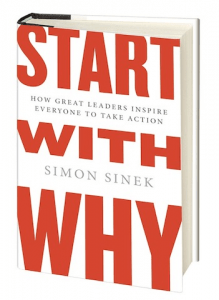 “People don’t buy WHAT you do, they buy WHY you do it.”
“People don’t buy WHAT you do, they buy WHY you do it.”
I recently finished reading a book called Start With Why by Simon Sinek, which I highly recommend.
The book spells out a belief that all great companies, organizations, products, and/or leaders succeed because they have a strong sense of “why” that inspires people beyond the “what” and “how” of what they do.
Essentially, it suggests that in order to succeed at something you have to start with a strong “why” and let that guide exactly what you do and how you do it.
Here’s a few passages from the book that stuck with me:
First, a quick summary of the book’s main question.
“Very few people or companies can clearly articulate WHY they do WHAT they do. When I say WHY, I don’t mean to make money – that’s a result. By WHY I mean what is your purpose, cause, or belief? WHY does your company exist? WHY do you get out of bed every morning? And WHY should anyone care?”
The book offers an example of how Apple is guided by its Why first, followed by its How and then its What. Here’s a hypothetical Apple mission statement:
“Everything we do, we believe in challenging the status quo. We believe in thinking differently.
The way we challenge the status quo is by making our products beautifully designed, simple to use, and user-friendly.
And we happen to make great computers. Wanna buy one?”
But the idea of starting with why isn’t just limited to modern companies like Apple. The book also points out that there’s a long history of businesses that have failed in part because they ignored their Why.
“Consider the classic business school case of the railroads. In the late 1800s, the railroads were the biggest companies in the country. Having achieved such monumental success, even changing the landscape of America, remembering WHY stopped being important to them. Instead they became obsessed with WHAT they did – they were in the railroad business.
This narrowing of perspective influenced their decision making – they invested all their money in tracks and crossties and engines.
But at the beginning of the 20th Century, a new technology was introduced: the airplane. And all those big railroad companies eventually went out of business.
What if they had defined themselves as being in the mass transportation business? Perhaps their behavior would have been different. Perhaps they would have seen opportunities that they otherwise missed. Perhaps they would own all the airlines today.”
Another thing the book touches on that rings true to me from my work with comedians is the concept that whatever you do, it shouldn’t be for everybody.
“The goal of business should not be to do business with anyone who simply wants what you have. It should be to focus on people who believe what you believe. When we are selective about doing business only with those who believe in our WHY, trust emerges.”
The book also touches a lot on workplace environments, how to inspire employees, and what characteristics are found at successful companies.
“Average companies give their people something to work on. In contrast, the most innovative organizations give their people something to work toward. The role of a leader is not to come up with all the great ideas. The role of a leader is to create an environment in which great ideas can happen.”
The idea of starting with why isn’t limited to the business world. Sinek points out that it’s just as evident in leaders of any type and the causes that people rally behind.
“Martin Luther King’s speech itself served as a visceral reminder of the belief shared by everyone who stood there listening. And that speech was about what he believed, not how they were going to do it.
He gave the ‘I Have a Dream’ speech, not the ‘I Have a Plan’ speech. It was a statement of purpose and not a comprehensive 12-point plan to achieving civil rights in America. Dr. King offered America a place to go, not a plan to follow. The plan had its place, but not on the steps of the Lincoln Memorial.”
Again, I really can’t recommend this book highly enough if you’re remotely interested in business, marketing, or innovation. It will change the way you see the things around you.
You can get it here.